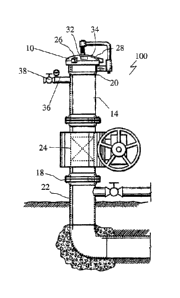Some of the information on this Web page has been provided by external sources. The Government of Canada is not responsible for the accuracy, reliability or currency of the information supplied by external sources. Users wishing to rely upon this information should consult directly with the source of the information. Content provided by external sources is not subject to official languages, privacy and accessibility requirements.
Any discrepancies in the text and image of the Claims and Abstract are due to differing posting times. Text of the Claims and Abstract are posted:
| (12) Patent: | (11) CA 2714132 |
|---|---|
| (54) English Title: | CLOSURE FOR A PIPELINE PIG SENDER OR RECEIVER |
| (54) French Title: | FERMETURE POUR EMETTEUR OU RECEPTEUR DE RACLEUR DE PIPELINES |
| Status: | Deemed expired |
| (51) International Patent Classification (IPC): |
|
|---|---|
| (72) Inventors : |
|
| (73) Owners : |
|
| (71) Applicants : |
|
| (74) Agent: | WOODRUFF, NATHAN V. |
| (74) Associate agent: | |
| (45) Issued: | 2015-04-07 |
| (22) Filed Date: | 2010-09-03 |
| (41) Open to Public Inspection: | 2012-03-03 |
| Examination requested: | 2013-08-27 |
| Availability of licence: | N/A |
| (25) Language of filing: | English |
| Patent Cooperation Treaty (PCT): | No |
|---|
| (30) Application Priority Data: | None |
|---|
A closure for pipeline pig sender or receiver includes a primary closure body and a secondary closure body. The primary closure body has an outer face, an inner face and a port extending therethrough from the outer face to the inner face. The primary closure body is secured to the pipeline pig sender or receiver sealing a closure end when the primary closure body is in the closed position. The secondary closure body closes the port on the primary closure body. The secondary closure body is movable between a closed position and an open position to enable an operator to insert a tool through the port into the diversionary passage to manipulate the pipeline pig and release trapped pressure prior to opening the closure. The secondary closure body is secured to the primary closure body sealing the port when the secondary closure body is in the closed position.
Fermeture pour émetteur ou récepteur de racleur de pipelines comprenant un élément de fermeture primaire et un élément de fermeture secondaire. Lélément de fermeture primaire présente une face externe, une face interne et un orifice allant de la face externe à la face interne. Lélément de fermeture primaire est fixé à lémetteur ou au récepteur de racleur de pipelines afin de sceller une extrémité de fermeture lorsque lélément de fermeture primaire est en position fermée. Lélément de fermeture secondaire ferme lorifice sur lélément de fermeture primaire. Lélément de fermeture secondaire est mobile; il peut passer dune position fermée à une position ouverte pour permettre à un opérateur dinsérer un outil à travers lorifice, dans le passage de détournement, afin de manipuler le racleur de pipelines et de libérer la pression coincée avant douvrir la fermeture. Lélément de fermeture secondaire est fixé à lélément de fermeture qui scelle lorifice lorsque lélément de fermeture secondaire est en position fermée.
Note: Claims are shown in the official language in which they were submitted.
Note: Descriptions are shown in the official language in which they were submitted.

For a clearer understanding of the status of the application/patent presented on this page, the site Disclaimer , as well as the definitions for Patent , Administrative Status , Maintenance Fee and Payment History should be consulted.
| Title | Date |
|---|---|
| Forecasted Issue Date | 2015-04-07 |
| (22) Filed | 2010-09-03 |
| (41) Open to Public Inspection | 2012-03-03 |
| Examination Requested | 2013-08-27 |
| (45) Issued | 2015-04-07 |
| Deemed Expired | 2018-09-04 |
There is no abandonment history.
| Fee Type | Anniversary Year | Due Date | Amount Paid | Paid Date |
|---|---|---|---|---|
| Application Fee | $200.00 | 2010-09-03 | ||
| Registration of a document - section 124 | $100.00 | 2011-10-05 | ||
| Maintenance Fee - Application - New Act | 2 | 2012-09-04 | $50.00 | 2012-08-29 |
| Request for Examination | $400.00 | 2013-08-27 | ||
| Maintenance Fee - Application - New Act | 3 | 2013-09-03 | $50.00 | 2013-08-27 |
| Maintenance Fee - Application - New Act | 4 | 2014-09-03 | $50.00 | 2014-08-26 |
| Final Fee | $150.00 | 2015-01-22 | ||
| Maintenance Fee - Patent - New Act | 5 | 2015-09-03 | $100.00 | 2015-09-01 |
| Maintenance Fee - Patent - New Act | 6 | 2016-09-06 | $100.00 | 2016-09-02 |
Note: Records showing the ownership history in alphabetical order.
| Current Owners on Record |
|---|
| BAKER, ALLEN D. |
| Past Owners on Record |
|---|
| NELSON, DAVID L. |
| NOWICKI, TRENT C. |